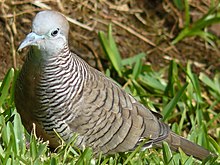Zebra dove
In 1743 the English naturalist George Edwards included a description and a picture of the zebra dove in his A Natural History of Uncommon Birds.
His drawing was made from a live specimen at the home of admiral Charles Wager in Parsons Green near London.
[3] When in 1766 the Swedish naturalist Carl Linnaeus updated his Systema Naturae for the twelfth edition, he included the zebra dove and placed it with all the other pigeons in the genus Columba.
Linnaeus included a brief description, coined the binomial name Columba striata and cited Edwards's work.
The native range of the species extends from Southern Thailand, Tenasserim, Peninsular Malaysia, and Singapore to the Indonesian islands of Sumatra and Java.
[9] The zebra dove is popular in captivity and many populations have appeared outside its native range due to birds escaping or being deliberately released.
It can now be found in central Thailand, Laos, Borneo, Sulawesi, Hawaii (introduced in 1922), Tahiti (1950), New Caledonia, the Seychelles, the Chagos Archipelago (1960), Mauritius (before 1768), Réunion, and Saint Helena.
It inhabits scrub, farmland, and open country in lowland areas and is commonly seen in parks and gardens.
They prefer to forage on bare ground, short grass or on roads, scurrying about with rodent-like movement.

